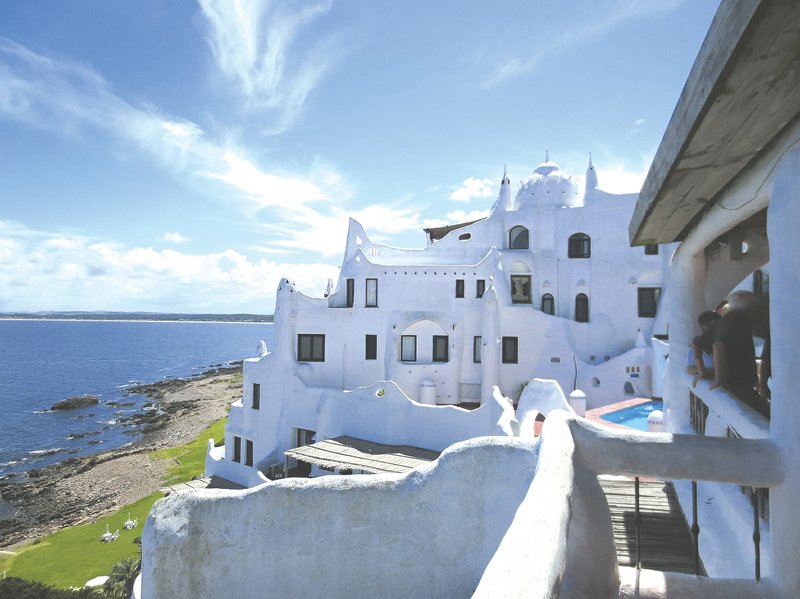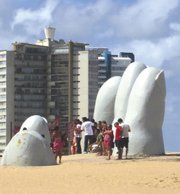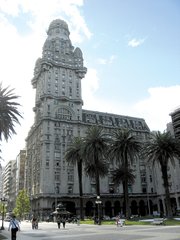Between Argentina and Brazil lies a country not much bigger than Arkansas in both population and geographical area. Not surprisingly, Uruguay attracts far fewer North American visitors than its much larger neighbors. But its interesting history, beautiful beaches, fine cuisine and stable government make it well worth a visit.
And then there are Uruguay's welcoming citizens. How welcoming? Well, one day as we explored Montevideo's old town, a local resident stopped us on the street to thank us for visiting her country -- and she was far from the only Uruguayan who expressed appreciation to us just for being there to enjoy this little jewel of a nation.
VISIT URUGUAY ONLINE
General tourism websites
Buquebus
Estancia Tourism
lares.com.uy
Bodega Bouza
Visitors to Uruguay generally make their base in the capital of Montevideo. This city of 1.3 million people sits at the mouth of the Rio de la Plata, which translates to "river of silver." The Spanish chose that name mistakenly assuming there were large deposits of silver upstream on this, the widest river in the world. Montevideo's Plaza Independencia separates the modern downtown from the old town with its colonial homes and landmark buildings -- such as the Solis Theater and the Cathedral of the Immaculate Conception. Near the port is the old Mercado del Puerto, which now houses a variety of restaurants, and a broad avenue called the Rambla runs for miles along the entire waterfront.
We stayed in the Punta Carretas neighborhood, which is on a point of land in the southern part of the city. Our hotel -- the Cala De Volpi -- faced the river along the Rambla, and we would end each day sitting in front of the big windows in our room enjoying a glass of wine and awaiting the sunset as we watched the passenger and cargo ships come and go. This neighborhood is home to a modern shopping mall, a golf club, the Holocaust Memorial and many restaurants, as well as several other hotels. We were within walking distance of the mall -- which has about 200 stores and a large food court. In front of this glitzy shopping center, you can catch buses to the modern downtown or the old town.
The Punta Carretas Mall itself has an interesting history. It was created out of a jail that held political prisoners during Uruguay's military dictatorship -- which began in 1973 and ended in 1985. When the mall opened in 1994, it was not only a welcome addition to the urban shopping scene, but also a symbol of Uruguay's return to democracy. While we were visiting, Uruguay's president was still Jose Alberto "Pepe" Mujica Cordano -- a former guerilla fighter who had resisted that military dictatorship. Famous for his simple lifestyle, as president, Pepe spurned the presidential palace and limousines in favor of a small farm outside Montevideo and a 1987 Volkswagon Beetle. Most Uruguayans we visited with spoke about him with great pride.
Montevideo has a wealth of cultural institutions -- including museums of visual arts, decorative arts and contemporary art. There is a naval museum and an Uruguayan history museum, which is divided between a number of historic houses. We spent much of our week in Uruguay taking day trips out of Montevideo, so we visited only two museums and one of the National History Museum's historic houses. We started with the Carnaval Museum, which is in a former warehouse complex near the port.
Rio de Janeiro's Carnaval might be the biggest such celebration, but it lasts for only a few days. In Montevideo, Carnaval goes on for more than 40 days, during which the city reverberates with the rhythm of candombe drums. Most of Montevideo's residents are of Spanish or Italian descent. But Montevideo was a trans-Atlantic slave trade port and is also home to a lively Afro-Uruguayan community. That community originated candombe, but in the late 1800s, this African-inspired style of drumming spread throughout the population. At the Carnaval Museum, you can see costumes, instruments and masks, and can experience past festivals through video and audio.
We also visited the Gaucho and Mint museums, which are housed together in an elaborate 1896 mansion. Uruguay and Argentina have much in common -- although the two nations are rivals, especially in soccer. Both nations share a love of mate -- the stimulating herbal tea made from the yerba plant -- and both share the gaucho heritage. Like Argentina, Uruguay has its pampas -- rolling plains where South American cowboys have for centuries herded cattle and sheep on large estancias. The Gaucho Museum is a fine introduction to gaucho gear and lore, but if you want to delve deeper into gaucho life, you can visit an estancia for a day -- or even stay overnight -- at one of several tourist ranches.
We also toured the Guiseppe Garibaldi house. Garibaldi's life illustrates the part Italian immigrants have played in Uruguayan life. Garibaldi is best known for his role in the formation of a unified Italy. But from 1841 to 1848, he lived in Uruguay, where he worked as a trader and schoolmaster. He met his wife Anita while fighting for a separatist republic in southern Brazil, and three of their four children were born in Montevideo. In 1842, Garibaldi took command of the Uruguayan fleet and raised an "Italian Legion" to fight on behalf of one faction in a Uruguayan civil war. After returning to Italy in 1848, Garibaldi commanded many military campaigns leading up to the unification of Italy under Victor Emmanuel as its first king. But his part in Uruguayan history is preserved in this historic house museum.
We took three day trips out of Montevideo during our stay -- one, a half-day visit to a winery. Chile has Carmenere, Argentina has Malbec, and Uruguay has Tannat. This dry, bold red wine is made from grapes brought to Uruguay by a Basque immigrant in the late 1800s. We didn't develop a taste for Tannat on its own, but did sample some nice wines that used it as a major part of a blend. A convenient winery to visit is the Bodega Bouza, which is located on the outskirts of Montevideo. After touring the winery and taking a look at the fine display of vintage motorcycles and cars, you can enjoy lunch in the restaurant.
Two must-do all-day tours are to Colonia del Sacramento (Colonia for short) and to Punta del Este. The old town of Colonia is also a convenient day trip from Buenos Aires. Buquebus offers fast and slow ferries from Buenos Aires to Colonia, and you can even arrange for lunch and a guided tour through that company. From Montevideo, several tour companies offer all-day bus excursions to Colonia, which include a guided tour of the old quarter and lunch.
Founded in 1680 by Portugal, Colonia over the years changed hands back and forth between that nation and Spain. The street plan of modern Colonia reflects the influence of Spanish urban design, but the historic old quarter features winding streets reminiscent of old Lisbon. The architecture of this UNESCO World Heritage Site blends Portuguese and Spanish building traditions. On both sides of meandering cobbled streets, modest buildings with tile roofs and stucco-covered stone walls now house shops, bars and restaurants. The old quarter is also home to the oldest church in Uruguay and the remains of an 1857 lighthouse.
Punta del Este is as modern and glittering as Colonia is old and quaint. Between December and February, Punta del Este attracts the rich and beautiful from Argentina, Brazil and Europe. The coastline of the resort is divided into two regions -- Brava (Spanish for "fierce") and Mansa (meaning "tame"). The division between the two beaches is marked by sculpted fingers emerging from the sand. The work of Chilean artist Mario Irarrazabal, La Mano ("The Hand") was completed in 1982 and is today one of Uruguay's most recognized landmarks.
Tours to Punta del Este usually include a view of the beach city of Piriapolis, where Uruguayan families prefer to spend their summer vacations. Founded in 1890 by Francisco Piria, this resort town has several large hotels, casinos and a waterfront promenade. Our tour bus took us up to the nearby Temple of San Antonio, where we had a fine view of Piriapolis and the surrounding coast. Tours to Punta del Este also stop at Casapueblo, the house designed by Uruguayan artist Carlos Paez Vilaro. Vilaro began work on the project in 1958, and he described the structure as "a living sculpture," built over 36 years without set plans. Today, Vilaro's home is a museum, gift shop, hotel and restaurant, with stunning views to the sea from its terraces.
So as you can see, Uruguay has plenty of offer the visitor. If you visit Buenos Aires, be sure to take a day trip to Colonia. And if you can, set aside at least a week sometime to really explore Montevideo and the rest of Uruguay. You won't regret it.
NAN Our Town on 02/04/2016



